1970 Icon Ford F-100 Reimagines Vintage-Truck Life
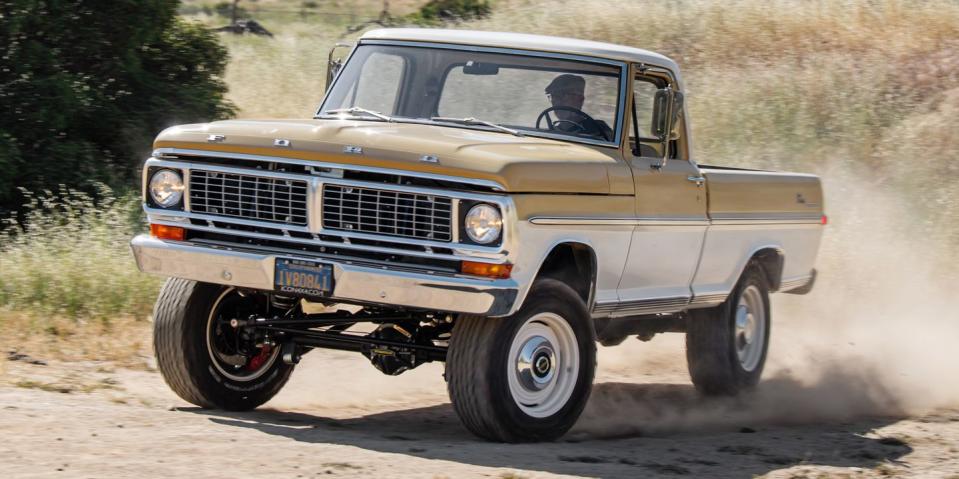
Left hand at 11 o'clock, right at one o'clock, forearms straight down with elbows at the bottom of the steering wheel. And that wheel is up against the driver's chest. It's the classic early pickup-truck-driving position. The way a truck without power steering and a confined cab had to be driven. Leverage was needed to steer, and there just wasn't any room to push the seat back. It's also the driving position for Icon's hard-core, high-end, obsessive-compulsive Reformer re-imagination of the short-bed, regular cab 1970 Ford F-100 4x4.
Jonathan Ward's Icon brand started as an offshoot of his classic Toyota Land Cruiser restoration and service business. It's now grown beyond boutique status to become a Southern California luxury brand. What Singer is to Porsche 911s, Icon is to old Ford Broncos, Chevrolet and GMC trucks from the early 1950s, Toyota FJs, and whatever else captures Ward's imagination or sparks the whimsy of a well-heeled customer.

Keep in mind that what Icon does is re-engineer and add overwhelming detail to old vehicles. What makes the Icon machines compelling is that they work so incredibly well. But there are built-in limitations.
What's easiest about modifying old cars and trucks is that, compared to new vehicles, they suck. So making them better is a pretty straightforward proposition: replace the archaic pieces with newer, better stuff. For this F-100, that starts with an all-new ladder frame built by Art Morrison Enterprises in Fife, Washington. It's a stretched version of the frame Icon uses under its Broncos, which C/D drove back in 2013. And that 23-inch stretch pays off.
Like the Icon Bronco, the F-100 uses Eibach coil springs at all four corners. In front, the Dana 44 solid axle is supported by a radius-arm setup and a Panhard rod. The rear, beefier Dana 60 axle is suspended on a four-link system. Fox Racing shocks dampen the ride motions. Big-ass Brembo brake rotors are aboard to do, well, the braking. They're controlled by a Wilwood master cylinder and Hydratech booster. The wheels are 18-inch alloys painted to resemble the original steelies and finished with the original-style Ford hubcaps. The adoption of the coil-spring suspension necessitated raising the bed floor two inches to accommodate the spring towers. (The F-100, like most four-wheel-drive pickups of the era, originally came with leaf springs front and rear.)
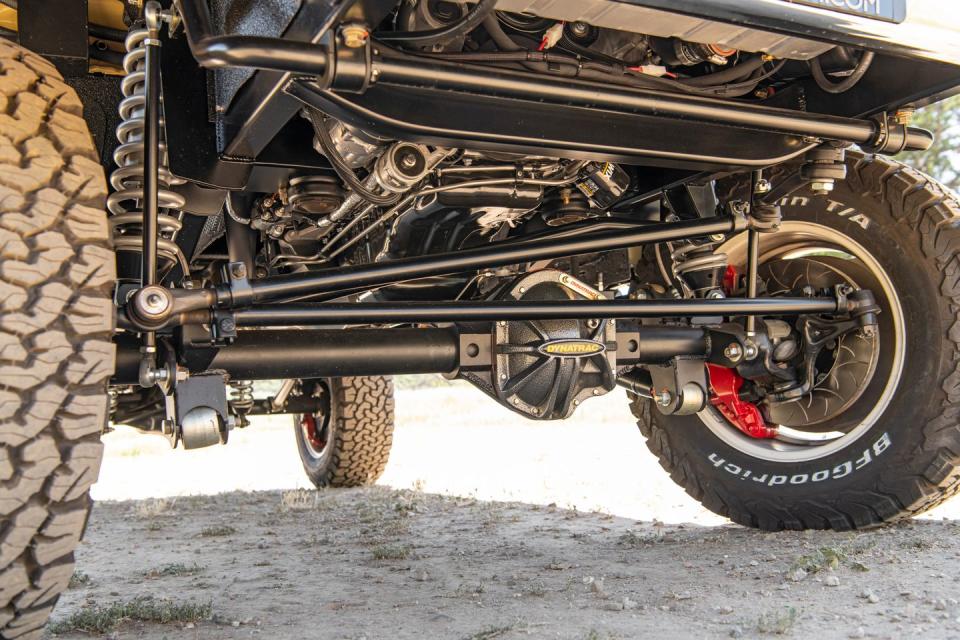
While the suspension system is virtually identical to the Icon Bronco's, the Bronco has a dinky 92-inch wheelbase. This short bed F-100 puts 115 inches between the front and rear axles. The stretch gives the pickup a much-settled, easygoing ride both on-road and off. The Bronco often feels nervous, like it's walking on its tiptoes. The F-100, on the other hand, is settled and confident. This pickup is a better everyday machine, even if it may sacrifice some of the Bronco's off-road nimbleness.
That raised bed floor also made it easier to fit a fuel tank behind the rear axle and between the frame rails. When Ford built this truck, the tank was in the cab behind the bench seat, where a good whack could atomize the fuel and potentially ignite and incinerate the occupants. Not good. The new tank is much safer and uses a filler positioned in the bed.
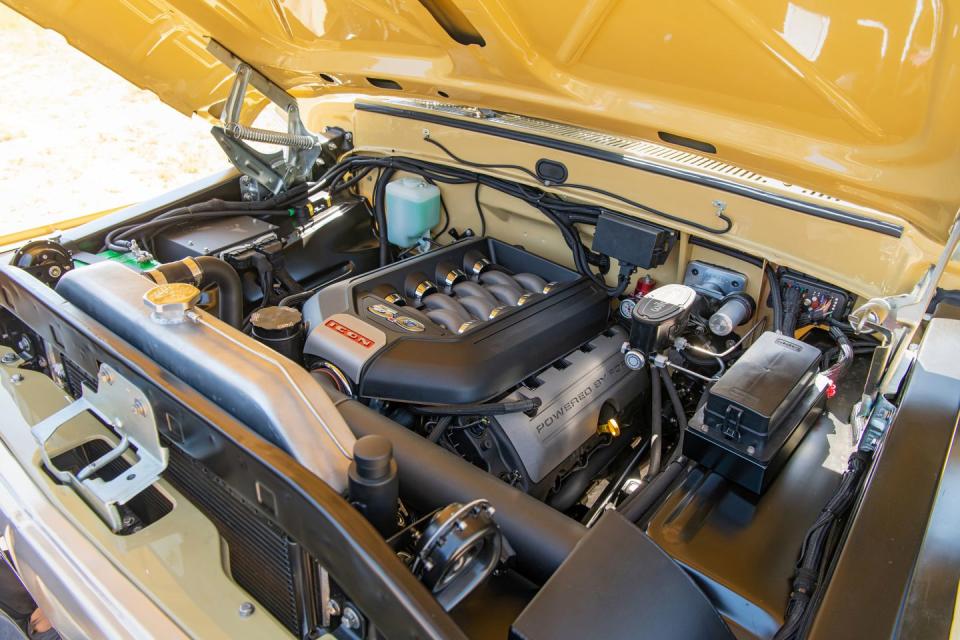
Again like Icon's Bronco, the F-100 is powered by Ford's 5.0-liter, DOHC, 32-valve V-8. Most prominently featured in the Mustang GT, the Coyote V-8 is rated at 460 horsepower in the 2020 edition of that pony car. The version in this truck, Icon says, is rated at 426 horsepower. "We've fattened up the torque curve," Ward explained. "We've become pretty good at managing the fuel map." Behind it is a Ford AOD four-speed automatic transmission, which in turn feeds an Advanced Adaptors Atlas II two-speed transfer case. Engaging the four-wheel-drive system takes a mighty tug on the transfer case's shift lever and getting out of the truck to twist the knobs on the manual front hubs.
Ford may be selling 10-speed automatics in its cars and trucks now, but the AOD four-speed automatic is better than good enough. The driver will never miss the other six gears. And really, today's high gear-count transmissions are about fuel economy ratings, not driving manners.

Ford introduced this body style (the fifth-generation F-Series) for the 1967 model year and made several clever design decisions. The big clamshell-style hood covers the fender tops so there's no sloppy panel gaps along the edges. And the drip rail around the doors continues around the front of the truck to disguise any roof seams. After all, Ford built 626,585 of these things during calendar year 1970 and was selling them cheap. The factory didn't have time to caress every single body panel. Jonathan Ward, on the other hand, was paid beaucoup bucks to make this one example perfect. So, his shop put in the hours to perfect the panel fit and drench the thing in enough coats of paint to repel artillery fire. Ward's crew started with a sweet 1970 truck in very good condition and didn't stop futzing until it glistened.
The full futz continues inside the cab, which appears factory with some slight exaggerations. The knobs were never this shiny when they left Ford, the upholstery so precisely tailored, and the gauges never so clearly marked and legible. An air-conditioning system using Vintage Air components keeps things cool while the close-cropped carpets feel so downy it's a shame to wear shoes.
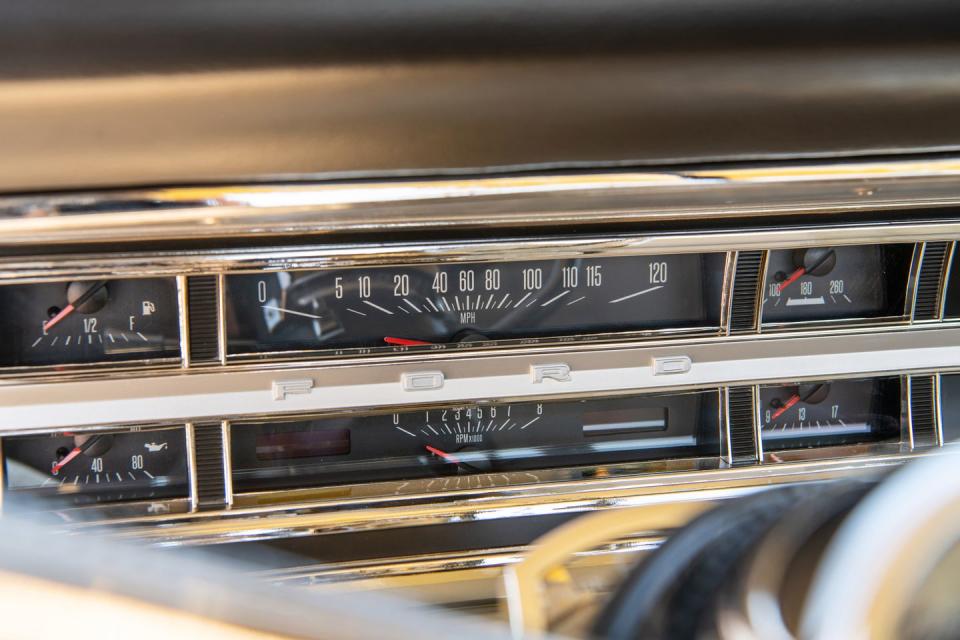
The Coyote V-8 sort of yelps to life and settles into a burbling idle. The column-mounted shifter snicks into drive, and the F-100 barks a bit and almost swaggers forward. Throttle response is good, the brakes bite with authority, and the steering is light and precise if somewhat mute.
Here's the truck's main drawback: It's still a 1970 Ford cab. That driving position described in the first paragraph isn't a choice, it's a necessity. There simply isn't enough cab to get comfortable by 21st century standards. One problem is that the restored stock steering wheel, necessarily huge in the days of unassisted steering, is simply too big in diameter for the current power-steering system. A two-inch reduction in diameter would make the steering feel more modern and open up some room for those of us carrying thunderous thighs down there.
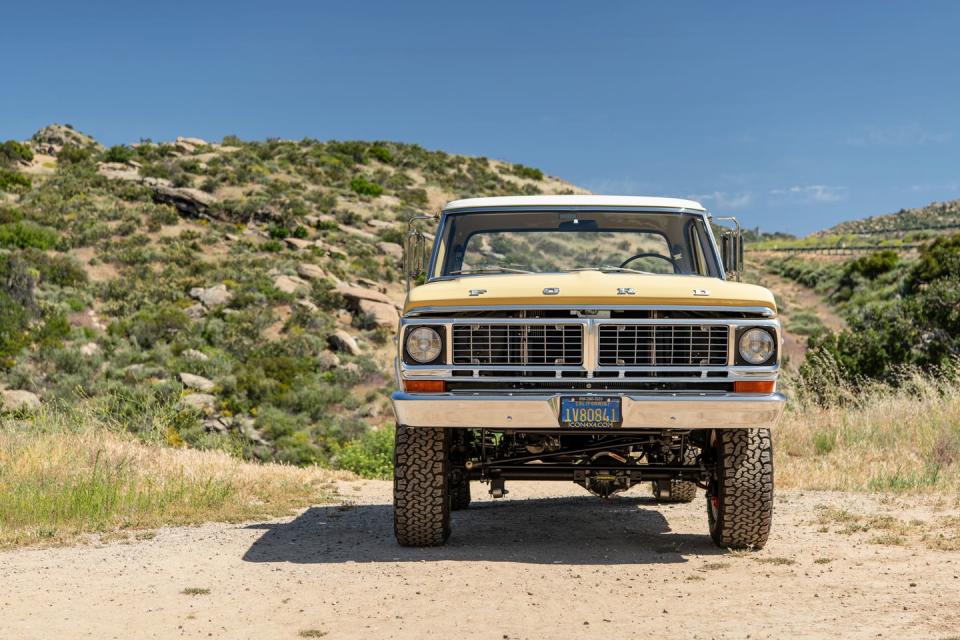
Aerodynamics were a dark art when this F-100 was in production. There's wind noise around the drip rails, and the big side mirrors are out there catching wind, too. Nothing so obtrusive as to detract from the truck's personality. But it's not a new F-150 King Ranch, either.
We're guessing here, but the zero-to-60-mph time is likely in the high six-second range. But slamming the accelerator pedal isn't what this is all about. There's a confidence and even-temperedness to this F-100 that nothing built in 1970 could ever approach.
Exposure to off-road conditions was limited. But there's good reason to expect fine manners there, too.

Managing one's expectations is the toughest part about re-tailoring an older vehicle for the 21st century. It's easy to make a 1970 Ford F-100 better, but there are limits to how good it can get. There's still a lot of 1970 in it.
Icon isn't shy about charging for its design expertise and fabrication skills. The build bill on this truck is up around $400,000, though the exact cost is between Icon and its customer. That could buy a really nice Rolls-Royce, but who'd want that when you can get an F-100?
You Might Also Like

 Yahoo Autos
Yahoo Autos 